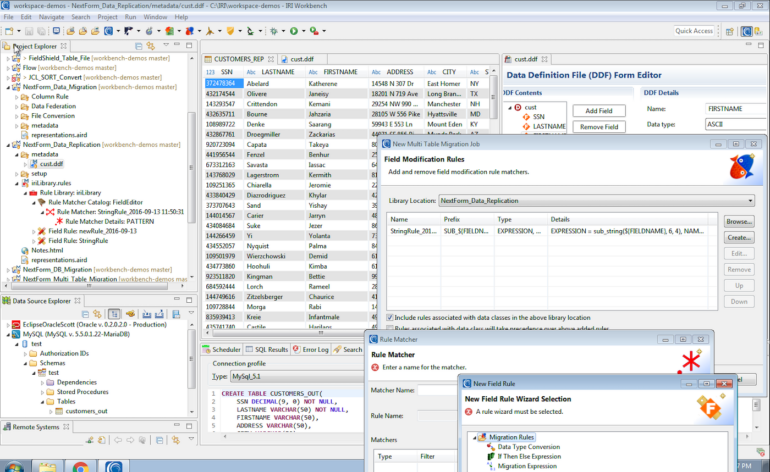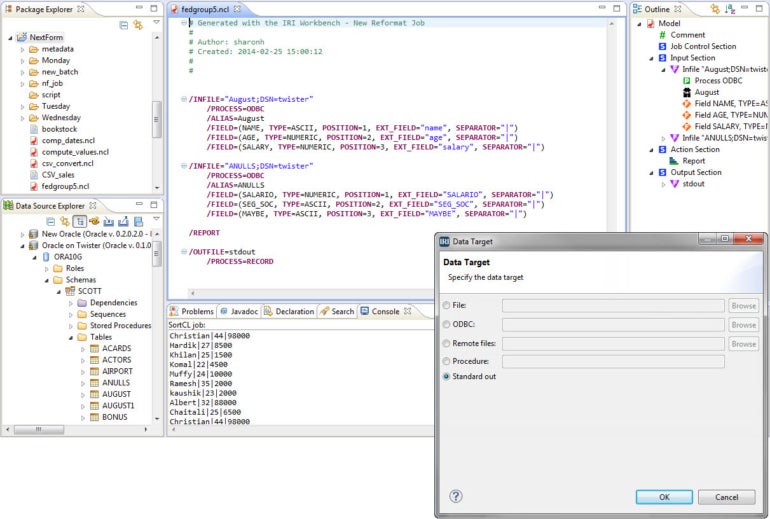[ad_1]

The data migration process for many organizations is ongoing. Whether you are going through a project to upgrade your systems, merging or consolidating with another company, or need to find a new home for your aging IT infrastructure, the process can be challenging to navigate without the right tools.
SEE: Checklist: PC and Mac migrations (TechRepublic Premium)
One tool designed to streamline this process is IRI’s NextForm, which allows you to migrate data, files and databases. This guide provides an overview of the solution to help you decide if this is the right tool for your needs.
Jump to:
An introduction to NextForm

NextForm by IRI, The CoSort Company, is an enterprise-grade database, data migration, replication and reformatting tool. It is built on Eclipse and offers a complete solution for legacy and modern databases.
The software provides different migration solutions — data, file and database — to suit various needs. It’s designed to work well with structured/relational databases like Oracle and SQL Server as well as unstructured/non-relational documents like XML and XLS.
This solution allows you to convert or replicate your database schema, data and file formats to new applications, hardware platforms and database vendors. It also supports indexing and sequential files, Hadoop clusters and unstructured data.
SEE: 5 tips to improve data quality for unstructured data (TechRepublic)
The data migration process can be challenging for enterprises with large volumes of data spanning multiple generations and media types. IRI NextForm streamlines this process by simplifying the conversion or replication workflows and accelerating insights through federation. With the IRI NextForm architecture and reporting interface, users can easily integrate different data sources into one cohesive view while preserving all metadata related to each source.
NextForm features
Built-in report generation

NextForm features a built-in report generation engine that allows you to migrate and expose information from multiple sources in custom displays that are suitable for billing and analytics. These reports can be used during migration and post-migration, and they can also be used as standalone reports. With NextForm, users can create highly customizable export reports and visualized views.
Cross-platform compatibility
NextForm can be used on Windows, Unix, Linux and macOS operating systems, and, generally, you can use it on any platform where you need to migrate data. Because you don’t have to create multiple jobs that are essentially the same, it will save you time in the migration process.
SEE: Linux 101: What tech pros need to know (TechRepublic Premium)
There’s also no need to worry about differences in command-line arguments or different formats for job names. The same jobs defined or running on the platform can be modified or run on any other.
Field layout remapping
IRI NextForm can convert data and files from one database to another, or even from one type of file to another. It also supports pivot transformations, reporting needs and database repopulation with its flexible layout transformation capabilities. IRI NextForm helps solve the challenges faced during data transformation, reformatting and reporting on big data sets with its robust suite of software tools.
The SortCL program in the CoSort product provides formatting conversion, federation and report generation, as well as flexible layouts for transforming different types of data and files for any need. This functionality helps IT teams consolidate data transformation tasks — such as sorting, joining and aggregating — that would otherwise be done separately.
Interoperable metadata
IRI NextForm is a migration solution that simplifies data migrations and allows users to maintain metadata consistency between the source and target. It maintains consistency by reusing definitions for metadata across the tools.
For example, if you have an ID field in CoSort but not in FieldShield, you can define it as an ID in FieldShield using the mapping metadata generated by CoSort.
Federation

IRI NextForm can be used to create virtual sets or federated views of data that you do not need to store. Connecting to your sources is fairly straightforward with the Eclipse GUI that automatically defines the metadata for data sources. After connecting, you can create jobs to blend and produce ad hoc database or file targets, including the GUI’s immediate console views, using stdout.
Remote database replication
IRI NextForm makes replicating many relational databases and mainframe datasets quick and easy. With IRI Workbench IDE built on Eclipse, you can use IRI NextForm to replicate data in real-time or batch. This software can synchronize heterogeneous data sources to use fresh copies for testing and reporting. IRI NextForm can run against most databases, including Sybase, Oracle and SQL Server.
With this tool, you can replicate multiple sources — such as relational or NoSQL tables — simultaneously. You can also output to multiple schemas or other targets or perform manipulations such as:
- Data deduplication and selection
- Data splitting
- Merging data elements
- Data cleansing
- Data enrichment
- Data validation
- Change data capture
- Normalization and denormalization
- Data sorting
- Data joining and aggregation
- Data masking
- Data encryption
Legacy data type translation
IRI NextForm migrates data in existing formats to the latest industry-standard formats. For example, it can convert a Microsoft Access database to a SQL Server database. It can also convert a text file in comma-separated values format to an Excel spreadsheet. With its ability to perform legacy data type translation, NextForm converts EBCDIC data files to ASCII.
SEE: Hiring kit: Database engineer (TechRepublic Premium)
This tool supports various file formats, including delimited text, fixed-position text, LDIF and micro-focus variable length. It also handles zoned and PD fields without any difficulty. It is straightforward to set up these parameters when converting with NextForm, especially since this software has been optimized for speed and accuracy.
Unstructured data management
IRI NextForm makes it easy for users to organize data from unstructured sources. It is perfect for migrating data from one database to another and extracting data values from various formats such as XML, PDF or DOCX.
It is best used in the following scenarios:
- When the user needs to extract data values from unstructured files
- When the user needs to migrate data between databases
- When the user needs to structure unstructured data
- When the user needs to expose associations for relational use
Pros and cons of NextForm
Although this tool offers many benefits for people who need to migrate data from one system to another, it does have a few drawbacks.
Pros
- Supports approximately 200 data sources, including legacy and modern databases
- Cross-platform support for Unix, Windows and Linux
- Eliminates vendor lock-in and lets you filter data to save storage and optimize I/O
- Available in various editions, including a free Lite version for migrating, replicating, federating and reporting on flat and unstructured text files
Cons
Pricing and trial info
IRI NextForm comes in six different editions. Pricing depends on the edition you choose and the type of operating system, databases and hardware platforms in question. When in doubt, talk to your internal team of data professionals to determine what edition works best.
| Edition | Costs |
|---|---|
| Lite | Free |
| COBOL | $3,500 for Windows $4,500 x86 for Linux $5,500 for Unix (AIX, Solaris, HP-UX, macOS) |
| DBMS | $5,000-$25,000 (depends on databases and hardware platforms) |
| Legacy | Pricing is determined by data sources and hardware platforms |
| Modern | Pricing is determined by data sources and hardware platforms |
| Premium | Pricing is determined by data sources and hardware platforms |
Read next: Top cloud and application migration tools (TechRepublic)
[ad_2]
Source link